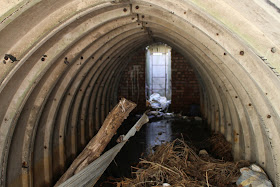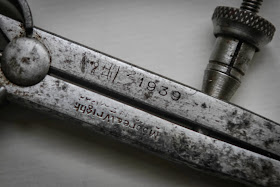Dora I & Dora II
Bomber command had campaigns to attack U-Boat pens on the Atlantic coast . The pens at Trondhiem escaped relatively unscathed .
 |
| Suspected Bomb damage on Dora II |
 |
| Like an Egyptian temple Dora II towers above its surroundings |
 |
| The fence around is to keep people away because its slowly falling apart . |
Dora I was small for a submarine pen hence the commencement of Dora II . The word small though is reletive.
Its HUGE .
Its 153m long 105m wide and there is more underground than above ground . Think of an oversized by a half football pitch with concrete poured upto the hight of the tallest of floodlights , thats how huge the building is !
 |
| view of the entrance to the pens |
Attacks on these two Pens were sporadic and ineffective . I have found only two reported major attacks .
The first major attack was on the 23rd July 1943 not long after DoraI came into service . Only very light damage was inflicted .
The second on either 12th or the 22nd November 1944 (there are two reports quoting different dates,which both suffered due to lack of visibility) .
One of these reports quotes bad weather for the aborted attack the other good use of smoke screen due to local experience with having to defend the Tirpitz which was moored near- by for a while .
Two Lancasters and a Mosquito were lost during these raids with little damage being caused .
It seems that many smaller attacks took place on Trondhiem , the port facilities and pens but only minor damage was ever inflicted to the pens.
 |
| Looking into a pen . the round columns are new and hold up the present day interior to Dora I |
 | |
| A shot of Dora I just after the war |
 | |
| Kapitans eye view . This is the view any Kapitan leaving the pens would have had from his conning tower |
 |
| The building behind is the Dahl brewery ...quite decent beer for Norway |
Its from HNoMS ULA S300 , a 207 Kobben class submarine that served the Norwegian navy from 1965 to 1990 . In 1987 this boats name was changed from ULA to KINN .
It was one of 15 207 Kobben class submarines commissioned by the Norwegian navy and built in Emden ,Germany .
Blast doors .
The Dora I pen had blast doors 30mm thick to protect it from bombing . In the shot above can be seen a gantry with Blast doors that perhaps covered doors and windows into the bunker .
To the left a shot of a part of one of the blast doors for the pen U-boat entrances themselves ....now used as a place to mount an info panel .
Leaning against the building can be seen other segments of the huge blast doors .
The roof itself was made from re-enforced concrete 3.8m thick , the walls of the same up to 2.5m thick .
The energy consumption for the Pens was immense ....just imagine how much power would be needed to shut the blast doors for instance . The ever pragmatic Germans built a power station between Dora I and Dora II which still stands today (see pic below) . No longer a power station it contains a Jujitsu club within its walls ...a different kind of power :-)
RAF Llanbedr
A 12 Group Fighter Command airfield during the war it was used as a gunnery school flying target tugs from it .
Post war it was used as a V-Force dispersal field and a drone testing centre .
It closed in 2004 . more recently it has been aquired by the Kemble Airfield Group and pilotless craft are once again flown and tested here .
the shots below are of some disused bunkers along side of a perimeter road by the airfield.
 |
| Hangers and outbuildings still in very useable condition |
 |
| I took a shot of the interior of this shelter |
 |
| inside the shelter |
A lucky find on my local flea market . I bought them because I thought they would be useful at work , at around 7'' long they are smaller and more solidly built than my other ones i use for marking out .
I started to clean them up at home when I noticed the date , 1939 ......no , i thought , they cannot be , can they ?
So a little more cleaning and a closer look ...and yes , a crown with AM stamped beneath .
Air Ministry issue dividers ....good uns too they even still have the very fine adjuster on the top . I have had a look on the net and they seem few and far between with a working adjuster ....its far more common for it to just be something to hold it by .
It made my day ...i,m easily pleased :-)
 |
| The AM is hard to see but its there ! |
Bomber Command Memorial
For years there was an omission in the commemorative monuments in London . That was the lack of one for the over 55,000 souls who lost their lives whilst serving in Bomber Command .
The political issues in glorious 20/20 hindsight of rights and wrongs should never have prevented a memorial being built to the brave men who flew these missions.
The memorial funded by public donation was finally unveiled by the Queen on the 28th June 2012.
These pictures are from my first and as yet only visit to the memorial.
The statue stands within an open sided columned room that has a roof with an open centre section .
The statue made from bronze by Philip Jackson features 7 crewmen (proportionate to the usual number on a Lancaster ) standing on a plinth . They appear to have just returned from a bombing raid ...or more fancifully perhaps they are 7 crewmen already destined not to return . You choose!
The details are superb , I cannot imagine that the sculpture would have been as good as this if it had been done postwar . At least the time delay as meant we now have possibly one of the best sculpture ever made of our fighting men .
The building made from Portland stone housing the sculpture is not without nuance . The roof structure represents the geodetic structure that made up the Wellington bombers airframe and to cap it all is actually manufactured from alloy taken from Halifax LW682 shot down over Belgium in 1944 . This aircraft was recovered from a bog in 1997 . Apparently 3 of the crewmen were still on board the aircraft when it was recovered . They are now interred in the area of Geraardsbergen near Flanders .
I was mightily impressed by the whole edifice and the thought that went into it .
Army Bombing Decoy Site at Oswaldtwistle Moor
This is an Army Bombing Decoy Site (A Series) built in an attempt to protect the Royal Ordnance factory in Blackburn in 1941 during the German bombing campaign against Britain .
It was both a QF site and a QL site .
QF means it used small fires to indicate strikes from incendiary bombs in the hope of fooling the German airmen to drop their bombs on the moor . QF was useful against aircraft following the lead aircaft .
QL refers to the use of lighting to try and decieve the bombers . This would be used prior to bombs being dropped once the lead aircraft had dropped their load more use of the QF would be made .
The shelter that remains has two areas within it . One large, one smaller with an escape hatch . The smaller one probaly contained a generator for the lights and the escape hatch may have doubled as an observation point for the controlling crew to remotely fire the various devices of subterfuge whilst remaining in a sort of safety ..... a sort of because a direct hit would no doubt kill all occupants therein .
It seems a dangerous job to invite aircraft to bomb your location .
 |
| view from the outside , with modern day wind turbines on the horizon |
 |
| The ladder for the escape hatch can be seen along with an asbestos lined vent and access for the generator |
 |
| View toward the entrance of the Army decoy site shelter |
This was a Civil Bombing Decoy Site . The two sites were combined and run as one later in the war .
Nothing now remains of the Starfish site ...we took photos of the area and a few enigmatic red bricks which are atypically found at dismantled Starfish sites .
 |
| Red bricks perhaps once of the command structure |
It is very definately an Army Bombing Decoy site. Varified in Colin Dobinson's excellent book Fields of Deception produced by English Heritage .
Suprisingly EH website Pastscape does not have the ABD site on thier pages but does have the Starfish site which is but a short distance away .
GermanWW2 items
Here are a few shots of Luftwaffe associated memorabilia that are owned by a friend of mine .
Above can be seen two examples of the very rare Butterfly bomb .The action of releasing them from the aircraft set a chain of events in motion . The 'wings' of the bomb deployed causing drag and the bomb would begin to spin downwards relitively slowly to earth ...the spinning motion armed the bomb . It could be set to go off either on impact or by timer . A small bomb that was released in clusters .
Below is a Heeres-Flakabzeichen awarded to Flak crews for shooting down Allied aircraft !
 |
| German incendaries . These rained down upon British cities in their thousands |
 |
| a selection of WW2 german gas masks , one of which is from a flak crew |
Halifax at Yorkshire Air Museum





















No comments:
Post a Comment